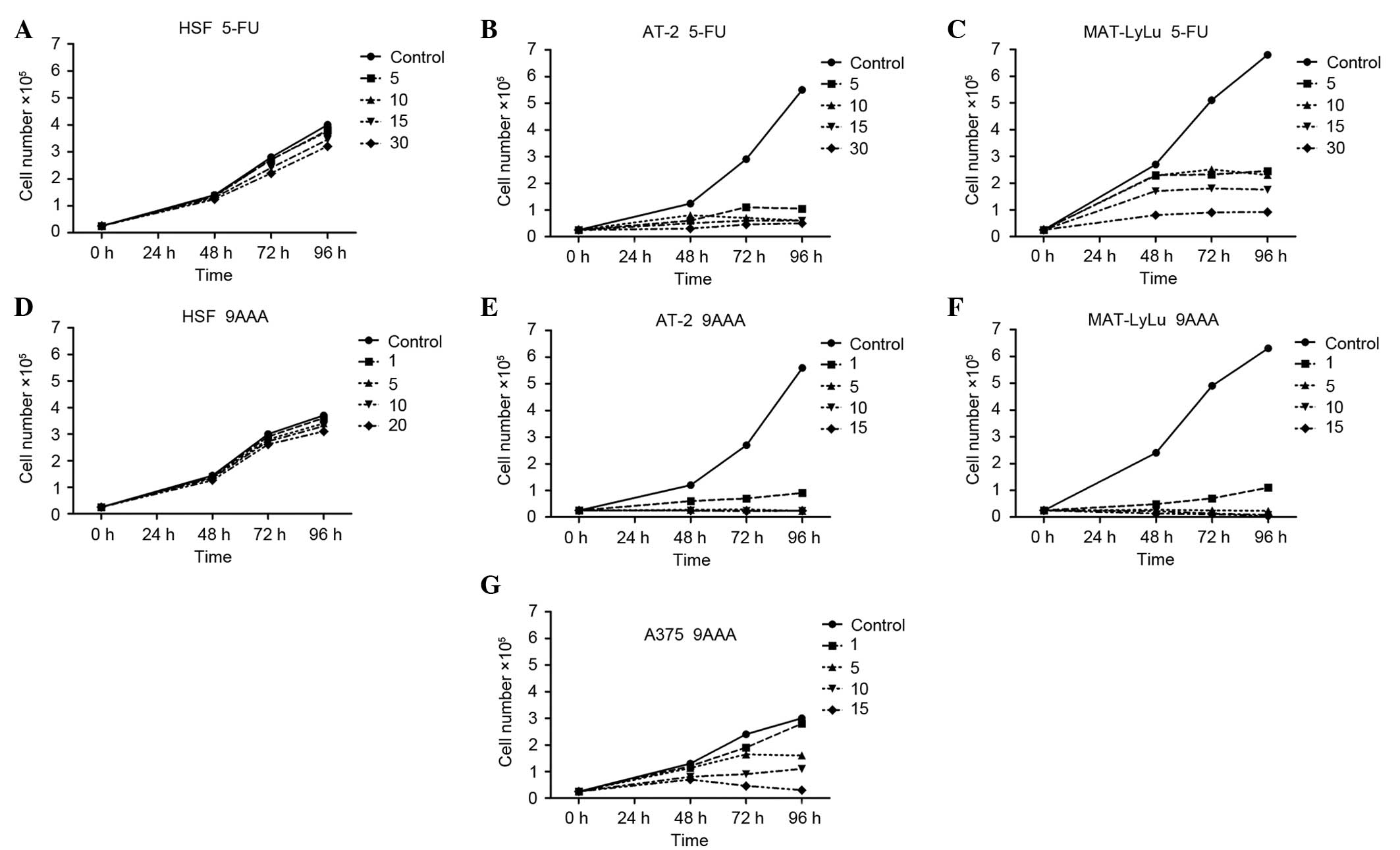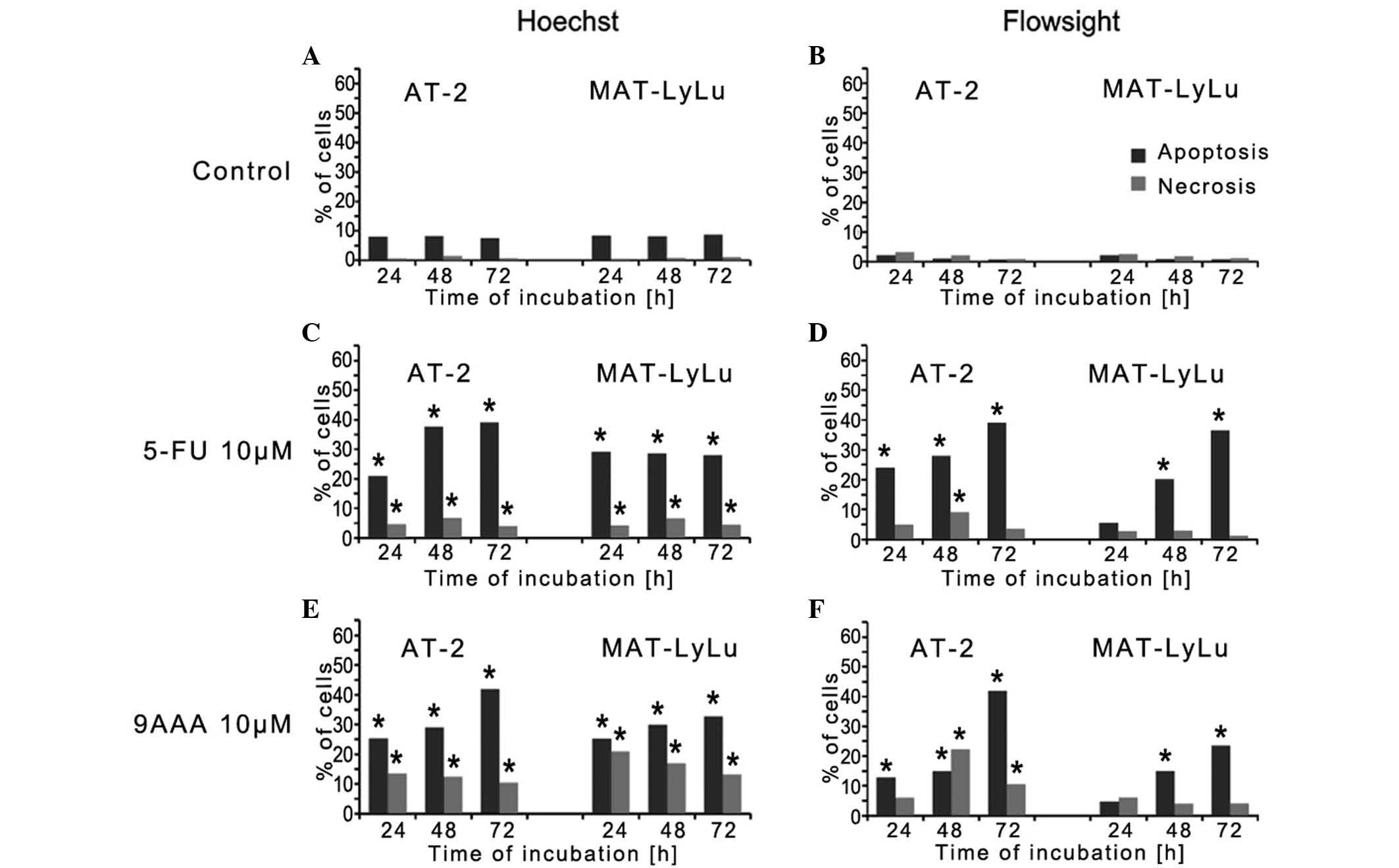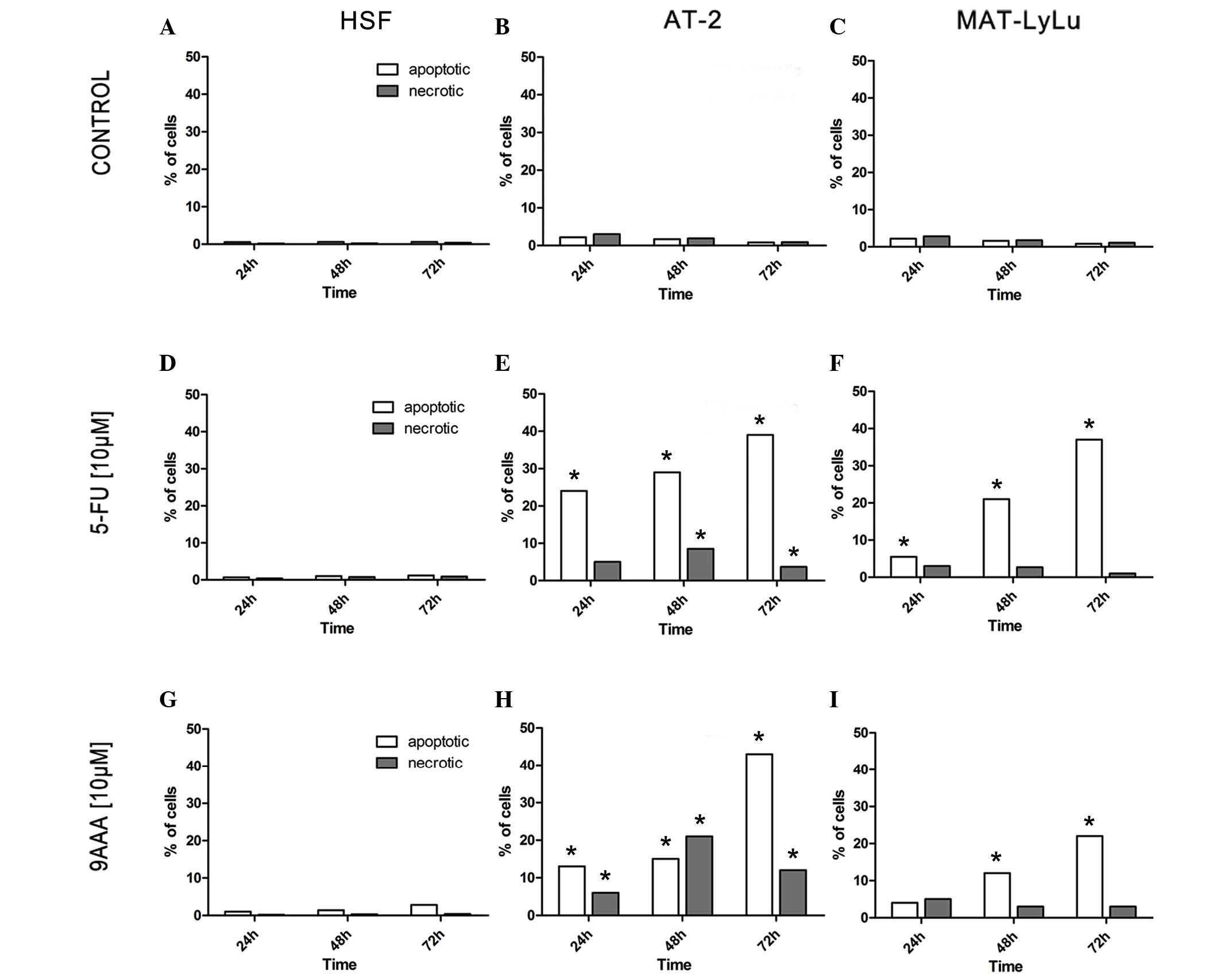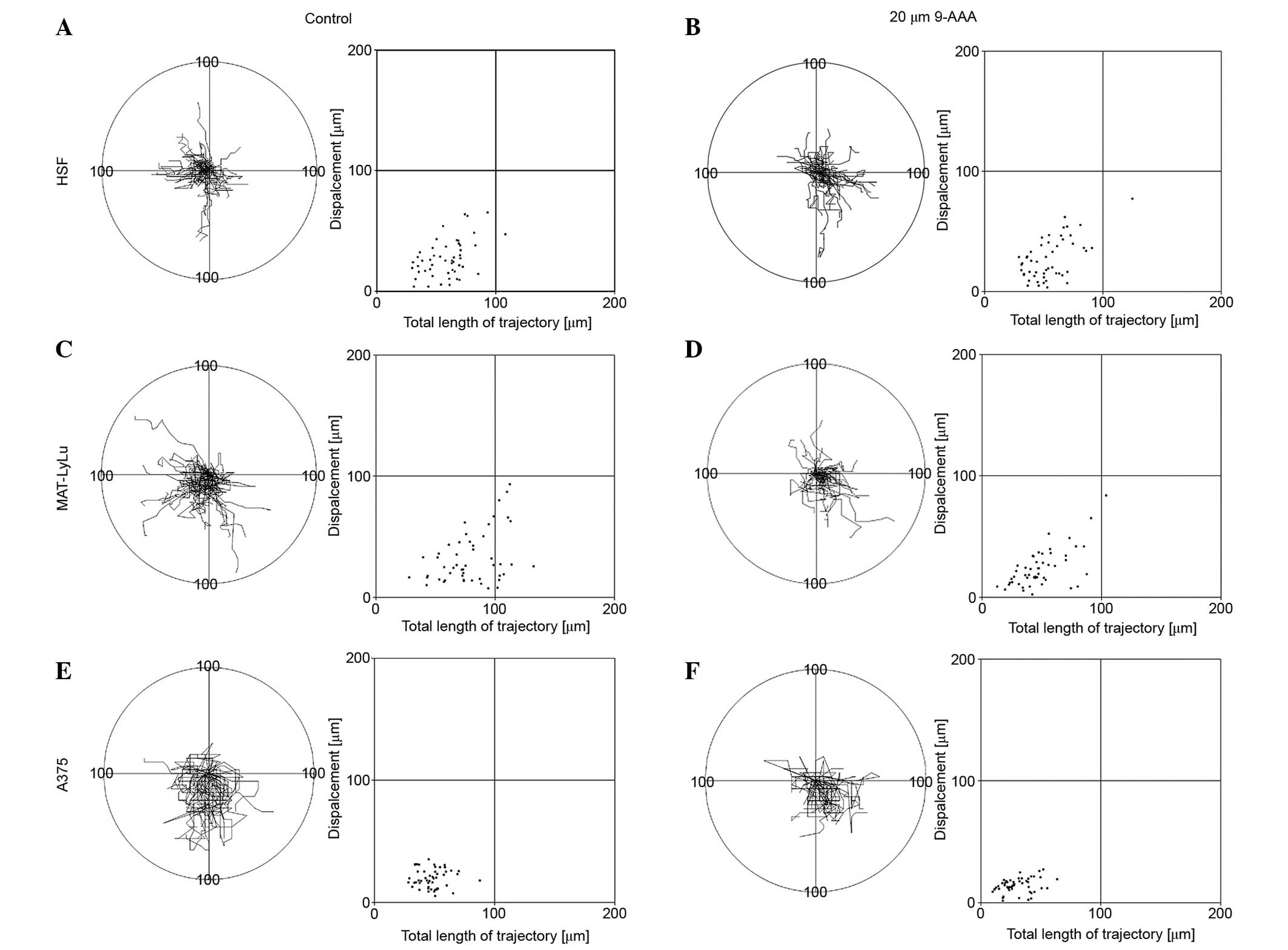|
1
|
Grys M, Madeja Z and Korohoda W:
Decreasing the thresholds for electroporation by sensitizing cells
with local cationic anesthetics and substances that decrease the
surface negative electric charge. Cell Mol Biol Lett. 19:65–76.
2014. View Article : Google Scholar : PubMed/NCBI
|
|
2
|
Wainwright M: Acridine-a neglected
antibacterial chromophore. J Antimicrob Chemother. 47:1–13. 2001.
View Article : Google Scholar : PubMed/NCBI
|
|
3
|
Sebestic J, Hlavácek J and Stibor I: A
role of the 9-aminoacridines and their conjugates in a life
science. Curr Protein Pept Sci. 8:471–483. 2007. View Article : Google Scholar : PubMed/NCBI
|
|
4
|
Valdés A: Acridine and acridinones: Old
and new structures with antimalarial activity. Open Med Chem J.
5:11–20. 2011. View Article : Google Scholar : PubMed/NCBI
|
|
5
|
Kopsidas G and MacPhee D: Glucose
inhibition of mutagenesis by 9-aminoacridine in Salmonella
typhimurium. Mutat Res. 285:101–108. 1993. View Article : Google Scholar : PubMed/NCBI
|
|
6
|
Kopsidas G and MacPhee D: Frameshift
mutagenesis by 9-aminoacridine: Antimutagenic effects of adenosine
compounds. Mutat Res. 352:135–142. 1996. View Article : Google Scholar : PubMed/NCBI
|
|
7
|
Acharya N, Abu-Nasr N, Kawaguchi G, Imai M
and Yamamoto K: Frameshift mutations produced by 9-aminoacridine in
wild-type, uvrA and recA strains of Escherichia coli; specificity
within a hotspot. J Radiat Res. 48:361–368. 2007. View Article : Google Scholar : PubMed/NCBI
|
|
8
|
Galluce M, Agar G, Aslan A, Karadayi M,
Bozari S and Orhan F: Protective effects of methanol extracts from
Cladonia rangiformis and Umbilicaria vellea against known mutagens
sodium azide and 9-aminoacridine. Toxicol Ind Health. 27:675–682.
2011. View Article : Google Scholar : PubMed/NCBI
|
|
9
|
Hoffmann GR, Laterza AM, Sylvia KE and
Tartaglione JP: Potentation of the mutagenicity and
recombinagenicity of bleomycin in yeast by unconventional
intercalating agents. Environ Mol Mutagen. 52:130–144. 2011.
View Article : Google Scholar : PubMed/NCBI
|
|
10
|
Koschelev SG and Khodorov BI: Blockade of
open NMDA channel by tetrabutylammonium, 9-aminoacridine and
tacrine prevents channels closing and desensitization.
Biologicheskie Membrany. 9:93–110. 1995.
|
|
11
|
Kim KH, Gmiro VE, Tikhonov DB and
Magazanik LG: Mechanism of blockade of glutamate receptor ionic
channels: Paradox of 9-aminoacridine. Biochemistry (Moscow)
Supplement Series A: Membrane and Cell Biology. 1:88–95. 2007.
View Article : Google Scholar
|
|
12
|
Barygin OI, Luchkina NV, Gmiro VE and
Tikhonov DB: Different mechanisms of the 9-aminoacridine block of
NMDA-and AMPA-receptor ion channels. Biologicheskie Membrany.
26:280–286. 2009.
|
|
13
|
Muravenko OV, Amosova AV, Samatadze TE,
Popov KV, Poletaev AI and Zelenin AV: 9-aminoacridine: An efficient
reagent to improve human and plant chromosome banding patterns and
to standardize chromosome image analysis. Cytometry A. 51:52–57.
2003. View Article : Google Scholar : PubMed/NCBI
|
|
14
|
Theuvenet AP, Van De Wijngaard WM, Van De
Rijke JW and Borst-Pauwels GW: Application of 9-aminoacridine as a
probe of the surface potential experienced by cation transporters
in the plasma membrane of yeast cells. Biochim Biophys Acta.
775:161–168. 1984. View Article : Google Scholar
|
|
15
|
Ivanov AG and DiCosmo F:
Microelectrophoretic and 9-aminoacridine fluorescence study of the
surface electrical properties of suspension cultured Catharanthus
roseus cells and isolated protoplasts: Effects of abscinic acid
treatment. Plant Cell Physiol. 36:709–715. 1995.
|
|
16
|
Gage RA, Theuvenet AP and Borst-Pauwels
GW: Effect of plasmolysis upon monovalent cation uptake,
9-aminoacridine binding and the zeta potential of yeast cells.
Biochim Biophys Acta. 854:77–83. 1986. View Article : Google Scholar
|
|
17
|
Aharon D, Weitman H and Ehrenberg B: The
effect of liposomes' surface electric potential on the uptake of
hematoporphyrin. Biochim Biophys Acta. 1808:2031–2035. 2011.
View Article : Google Scholar : PubMed/NCBI
|
|
18
|
Radzikowski C, Ledóchowski Z, Ledóchowski
A, Wrzołek S, Hrabowska M and Konopa J: The evaluation of antitumor
properties of acridine derivatives on the basis of the results from
some in vivo and in vitro tests. Arch Immunol Ther Exp (Warsz).
15:126–128. 1967.PubMed/NCBI
|
|
19
|
Mendecki J, Więckowska Z and Chorąży M:
Inhibition of RNA synthesis by 9-aminoacridine in regenerating rat
liver and cell culture. Acta Biochim Pol. 16:253–262.
1969.PubMed/NCBI
|
|
20
|
Rehn C and Pindur U: Molecular modeling of
intercalation complexes of antitumor active 9-aminoacridine and a
[d, e]-anellated isoquinoline derivative with base paired
deoxytetranucleotides. Monatshefte für Chemie. 127:645–658. 1996.
View Article : Google Scholar
|
|
21
|
Murza A, Sánchez-Cortéz S, Garcia-Ramos
JV, Guisan JM, Alfonso C and Rivas G: Interaction of the antitumor
drug 9-aminoacridine with guanidinobenzoatase studied by
spectroscopic methods: A possible tumor marker probe based on the
fluorescence exciplex emission. Biochemistry. 39:10557–10565. 2000.
View Article : Google Scholar : PubMed/NCBI
|
|
22
|
Temple MD, Recabarren P, McFadyen WD,
Holmes RJ, Denny WA and Murray V: The interaction of DNA-targeted
9-aminoacridine-4-carboxamide platinum complexes with DNA in intact
human cells. Biochim Biophys Acta. 1574:223–230. 2002. View Article : Google Scholar : PubMed/NCBI
|
|
23
|
Kumar P, Kumar R and Prasad DN: Synthesis
and biological evaluation of new 9-aminoacridine-4-carboxamide
derivatives as anticancer agents: 1st Cancer Update. Arab J Chem.
6:59–65. 2013. View Article : Google Scholar
|
|
24
|
Wang WG, Ho WC, Dicker DT, MacKinnon C,
Winkler JD, Marmorstein R and El-Deiry WS: Acridine derivatives
activate p53 and induce tumor cell death through Bax. Cancer Biol
Ther. 4:893–898. 2005. View Article : Google Scholar : PubMed/NCBI
|
|
25
|
Ryan E, Blake AJ, Benoit A, David MF and
Robert AK: Efficacy of substituted 9-aminoacridine derivatives in
small cell lung cancer. Invest New Drugs. 31:285–292. 2013.
View Article : Google Scholar : PubMed/NCBI
|
|
26
|
Reiss K and Korohoda W: The formation of
myotubes in cultures of chick embryo myogenic cells in serum-free
medium is induced by the insulin pulse treatment. Folia Histochem
Cytobiol. 26:133–141. 1988.PubMed/NCBI
|
|
27
|
Reiss K, Kajstura J and Korohoda W: The
insulin signal initiating cellular differentiation is preserved by
chick embryo myoblasts incubated at 2°C. Europ J Cell Biol.
53:42–47. 1990.PubMed/NCBI
|
|
28
|
Longley DB, Harkin DP and Johnston PG:
5-fluorouracil: Mechanisms of action and clinical strategies. Nat
Rev Cancer. 3:330–338. 2003. View
Article : Google Scholar : PubMed/NCBI
|
|
29
|
Raghunathan K and Priest DG: Modulation of
fluorouracil antitumor activity by folic acid in a murine model
system. Biochem Pharmacol. 58:835–839. 1999. View Article : Google Scholar : PubMed/NCBI
|
|
30
|
Djamgoz MBA, Mycielska M, Madeja Z, Fraser
SP and Korohoda W: Directional movement of rat prostate cancer
cells in direct-current electric field. Involvement of voltagegated
Na+ channel activity. J Cell Sci. 114:2697–2705.
2001.PubMed/NCBI
|
|
31
|
Waligórska A, Wianecka-Skoczeń M, Nowak P
and Korohoda W: Some difficulties in research into cell motile
activity under isotropic conditions. Folia Biol (Kraków). 55:9–16.
2007. View Article : Google Scholar
|
|
32
|
Musialik E, Ryszawy D, Madeja Z and
Korohoda W: Morpho-physiological heterogeneity of cells within two
rat prostate carcinoma cell lines AT-2 and MAT-LyLu differing in
the degree of malignancy observed by cell cloning and the effects
of caffeine, theophylline and papaverine upon a proportion of the
clones. Oncol Rep. 29:1789–1796. 2013.PubMed/NCBI
|
|
33
|
Ryszawy D, Sarna M, Rak M, Szpak K,
Kędracka-Krok S, Michalik M, Siedlar M, Zuba-Surma E, Burda K,
Korohoda W, et al: Functional links between Snail-1 and Cx43
account for the recruitment of Cx43-positive cells into the
invasive front of prostate cancer. Carcinogenesis. 35:1920–1930.
2014. View Article : Google Scholar : PubMed/NCBI
|
|
34
|
Gurova KV, Hill JE, Guo C, Prokvolit A,
Burdelya LG, Samoylova E, Khodyakova AV, Ganapathi R, Ganapathi M,
Tararova ND, et al: Small molecules that reactivate p53 in renal
cell carcinoma reveal a NF-kappaB-dependent mechanism of p53
suppression in tumors. Proc Natl Acad Sci USA. 102:17448–17453.
2005. View Article : Google Scholar : PubMed/NCBI
|
|
35
|
Guo C, Gasparian AV, Zhuang Z, Bosykh DA,
Komar AA, Gudkov AV and Gurova KV: 9-aminoacridine-based anticancer
drugs target the PI3K/AKT/mTOR, NF-kappaB and p53 pathways.
Oncogene. 28:1151–1161. 2009. View Article : Google Scholar : PubMed/NCBI
|
|
36
|
Teitelbaum AM, Gallardo JI, Bedi J, Giri
R, Renoit AR, Olin MR, Morizio KM, Ohlfest JR, Remmel RP and
Ferguson DM: 9-Amino acridine pharmacokinetics, brain distribution
and in vitro/in vivo efficacy against malignant glioma. Cancer
Chemother Pharmacol. 69:1519–1527. 2012. View Article : Google Scholar : PubMed/NCBI
|
|
37
|
Galvez-Peralta M, Hackbarth JS, Flatten
KS, Kaufmann SH, Hiasa H, Xing C and Ferguson DM: On the role of
topoisomerase I in mediating the cytotoxicity of
9-aminoacridine-based anticancer agents. Bioorg Med Chem Lett.
19:4459–4462. 2009. View Article : Google Scholar : PubMed/NCBI
|
|
38
|
Abercrombie M and Ambrose EJ: The surface
properties of cancer cells: A review. Cancer Res. 22:525–548.
1962.PubMed/NCBI
|
|
39
|
Carter HB and Coffey DS: Cell surface
charge in predicting metastatic potential of aspirated cells from
the Dunning rat prostatic adenocarcinoma model. J Urol.
140:173–175. 1988.PubMed/NCBI
|
|
40
|
Mehrishi JN: Molecular aspects of the
mammalian cell surfaceProgress in Biophysics and Molecular Biology.
Butler JAV and Noble D: Pergamon Press; Oxford: pp. 3–70. 1972
|
|
41
|
Mehrishi JN and Bauer J: Electrophoresis
of cells and the biological relevance of surface charge.
Electrophoresis. 23:1984–1994. 2002. View Article : Google Scholar : PubMed/NCBI
|
|
42
|
Korohoda W and Wilk A: Cell
electrophoresis-a method for cell separation and research into cell
surface properties. Cell Mol Biol Lett. 13:312–326. 2008.
View Article : Google Scholar : PubMed/NCBI
|
|
43
|
Searle GF and Barber J: The involvement of
the electrical double layer in the quenching of 9-aminoacridine
fluorescence by negatively charged surfaces. Biochim Biophys Acta.
502:309–320. 1978. View Article : Google Scholar : PubMed/NCBI
|
|
44
|
Doyle GM and Mohler JL: Prediction of
metastatic potential of aspirated cells from the Dunning R-3327
prostatic carcinoma model. J Urol. 147:756–759. 1992.PubMed/NCBI
|
|
45
|
Wyckoff JB, Segall JE and Condeelis JS:
The collection of the motile population of cells from a living
tumor. Cancer Res. 60:5401–5404. 2000.PubMed/NCBI
|
|
46
|
Preet R, Mohapatra P, Mohanty S, Sahu SK,
Choudhuri T, Wyatt MD and Kundu CN: Quinacrine has anticancer
activity in breast cancer cells through inhibition of topoisomerase
activity. Int J Cancer. 130:1660–1670. 2012. View Article : Google Scholar : PubMed/NCBI
|













